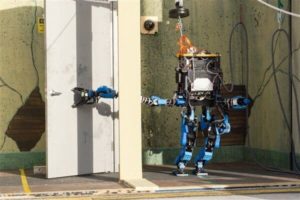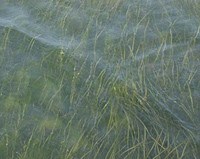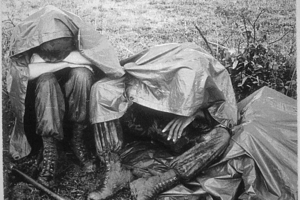american forces press service
Protection Equipment Demonstration: Something for Everyone
Under rows of tents and inside large aircraft hangars, more than 2,600 force protection products were demonstrated and exhibited for Defense Department, federal and local agencies at Force Protection Equipment Demonstration IV May 6-8. Among the highlights: Geocell Systems, which demonstrated how to build sand barriers using a foldable plastic device. The modular and collapsible plastic grids require no special tools and can be assembled in seconds to hold sand horizontally to any desired length. The grids are also stackable to hold sand vertically. Barney Greinke, director of marketing for the company, said the sand-filled wall can act as a barrier against vehicles, and can help stop small-arms fire and blast fragments from small bombs. “You have to understand that a wall of sand 4 feet wide by 8 feet tall weighs around 12,000 pounds,” Greinke said, “So it can be quite effective. It’s basically replaces the sandbag.”
WMD in Wrong Hands is ‘Greatest Security Risk’ This Decade
Weapons of mass destruction in the wrong hands is the “greatest security risk of this decade,” said deputy defense secretary Paul Wolfowitz during a symposium at the third annual Conference on Counterproliferation May 13. The United States will continue to have a requirement for a “robust WMD elimination capability” even after the discovery and the destruction of Iraq’s WMD capabilities, he noted.
Radiological and Bioterror-Attack Exercise Starts May 12
Citizens of Chicago and Seattle shouldn’t become alarmed if they see “space suit”-attired groups of people rushing around May 12. Such an event, Homeland Defense Secretary Tom Ridge noted here today, will just be part of a test of U.S. and Canadian federal, state and local government capabilities to meet a real-life terrorist radiological or biological weapons attack.
DoD Bolsters Service Members’ Post-Deployment Health Assessment Process
Thousands of active duty and reserve U.S. service members deployed overseas for Operation Iraqi Freedom will undergo an enhanced post-deployment health assessment process. The new health evaluation process was approved mid-April and is being implemented now to provide added safeguards for the health of deployed service members, Dr. William Winkenwerder, assistant secretary of defense for health affairs, told Pentagon reporters April 29.
Operation Iraqi Freedom Marks New Way of War Fighting
The successful application of teamwork and technology in Operation Iraqi Freedom marks a turning point in American war fighting, the U.S. military’s senior officer said. “What we’ve done in Iraq has been dramatically different” than how the American military has fought wars since the Civil War, Air Force Gen. Richard B. Myers, the chairman of the Joint Chiefs of Staff, told a Navy League audience at a downtown hotel.
Pacific Command Limits Asia Trips Due to SARS Outbreak
Defense Department personnel may make only mission-essential trips to China and Hong Kong because of the threat of severe acute respiratory syndrome, U.S. Pacific Command officials said today. “All Hong Kong port visits by U.S. Navy ships will be deferred until the restriction has been lifted,” Pacific Command spokeswoman Lt. Cmdr. Jensin Sommer said. The restriction is consistent with recommendations made by the U.S. Centers for Disease Control and Prevention. The U.S. State Department has also issued a travel advisory citing the disease. The travel advisory includes China, Hong Kong, Singapore and Hanoi, Vietnam.
With Iraqi Regime Going Down the Tubes, Where's Saddam?
“Where is Saddam?” Defense Secretary Donald H. Rumsfeld asked today during an appearance on Fox News Sunday. Rumsfeld and Chairman of the Joint Chiefs of Staff Air Force Gen. Richard Myers said during appearances on various news programs that there has not been a verifiable appearance by the Iraqi dictator or his sons since the war began. In that time, Rumsfeld and Myers said, coalition forces have been pushing on many fronts to liberate Iraq. Forces have control of western Iraq, and coalition conventional forces are massing in northern Iraq as special operations forces lead local forces there in much the same way they did in Afghanistan.
Escalating 'Sensor War' Is the Face of Future Conflict
Military commanders of the future will employ high-tech sensing equipment to detect the strength and positions of enemy forces, including those attempting to hide from prying electronic eyes. “‘Sensor War’ is a fully two-sided ‘game,'” noted Arthur K. Cebrowski, director of DoD’s Transformation Office and a retired Navy vice admiral. “You want to sense something (and) the person or the thing that you’re trying to sense is owned by someone, so they take measures to make it more difficult for you to find it.” The concept of “Sensor War” isn’t far-fetched, he pointed out. Today’s firefighters, he noted, use heat-detecting equipment to find “hot spots” in burning buildings despite swirling smoke and dust.




